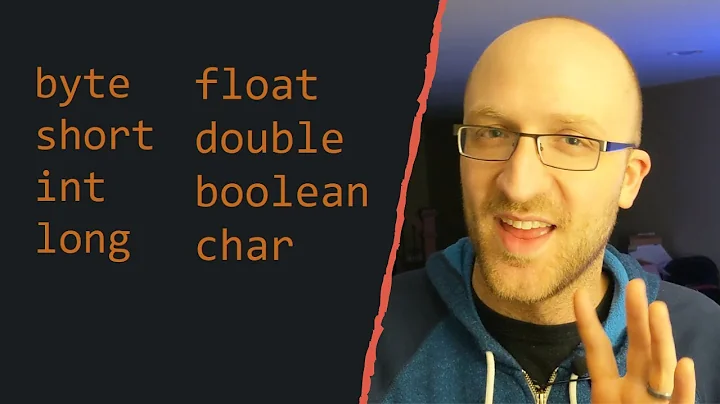Java Vector or ArrayList for Primitives
Solution 1
There is unfortunately no such class, at least in the Java API. There is the Primitive Collections for Java 3rd-party product.
It's pretty dangerous to use auto-boxing together with existing collection classes (in particular List implementations). For example:
List<Integer> l = new ArrayList<Integer>();
l.add(4);
l.remove(4); //will throw ArrayIndexOutOfBoundsException
l.remove(new Integer(4)); //what you probably intended!
And it is also a common source of mysterious NullPointerExceptions accessing (perhaps via a Map):
Map<String, Integer> m = new HashMap<String, Integer>();
m.put("Hello", 5);
int i = m.get("Helo Misspelt"); //will throw a NullPointerException
Solution 2
http://trove4j.sourceforge.net/
The Trove library provides high speed regular and primitive collections for Java.
Note that because Trove uses primitives, the types it defines do not implement the java.util collections interfaces.
(LGPL license)
Solution 3
Modern Java supports autoboxing of primitives, so you can say
List<Integer> lst = new ArrayList<Integer>;
lst.add(42);
That at least avoids the syntactic vinegar of new Integer(42).
Solution 4
There is also Primitive Collections for Java but it's a bit out of date.
Solution 5
Eclipse Collections has primitive ArrayLists for all primitive types, as well as primitive Sets, Bags, Stacks and Maps. There are immutable versions of all of the primitive container types as well.
Note: I am a committer for Eclipse Collections.
Related videos on Youtube
Daniel Bingham
Activist, writer, and software engineer based in Bloomington, IN. Currently Devops Lead at Ceros.
Updated on July 10, 2020Comments
-
Daniel Bingham almost 4 years
Is there an expandable array class in the Java API equivalent to the
VectororArrayListclass that can be used with primitives (int, char, double, etc)?I need a quick, expandable array for integers and it seems wasteful to have to wrap them in the
Integerclass in order to use them withVectororArrayList. My google-fu is failing me.-
 kevinarpe about 12 years+1 for "My google-fu is failing me."
kevinarpe about 12 years+1 for "My google-fu is failing me."
-
-
Daniel Bingham over 14 yearsThis is for commercial software development. While I think we're okay to use LGPL'd code I'd have to check with people, and in that case it'd probably be easier to just write my own class. I'll make note of the library for future Open Source stuff I write though, thanks!
-
 oxbow_lakes over 14 yearsThis is dangerous (reasons given below)
oxbow_lakes over 14 yearsThis is dangerous (reasons given below) -
skaffman over 14 yearsIf LGPL is off-limits, that rules out the a very large proportion of open-source libraries. What were you expecting?
-
Daniel Bingham over 14 yearsJust needed to know whether or not I was missing something in the JDK. LGPL isn't off limits, but I can write my own class in this case in less time than it would take to get the okay on the library, get it integrated and then write the code using it.
-
Daniel Bingham over 14 yearsSo in other words, use one of the third party libraries or write your own. Got it, thanks! :)
-
Thom Smith over 14 yearsIndeed -- some methods of Java collections are overloaded, and when autoboxing is involved, Java may resolve invocations that are conceptually ambiguous by selecting the non-autoboxed option rather than generating a compile-time error. Conceptually, the reason for this is that int and Integer are isomorphic, but there exists no subtype relationship between them. This kind of relationship exists nowhere else in Java but autoboxing (and a few esoteric issues with generics and type erasure).
-
starblue over 14 yearsnew Integer(42) is the wrong thing to do, use Integer.valueOf(42) for boxing.
-
Thom Smith over 14 yearsThe nice thing about autoboxing is that I don't have to remember that. ;-)
-
 Admin almost 14 years+ 1 for the remove(4) remove(new Integer(4)) example!
Admin almost 14 years+ 1 for the remove(4) remove(new Integer(4)) example! -
Stephan over 10 yearsPrimitive Collections for Java has been flagged as deleted on SourceForge.
-
Ayushi Jain about 6 years@oxbow_lakes why does l.remove throws a error? What is the reason behind this?
-
 Pradeep Gollakota about 6 years@ayushi it's because List has two remove() methods.
Pradeep Gollakota about 6 years@ayushi it's because List has two remove() methods.remove(int)andremove(E)...l.remove(4)says "remove the fourth element of the list". Whereas,l.remove(new Integer(4))says "remove the first occurrence of '4' in the list wherever that is". Check out the linked java docs for more detailed info. -
Ayushi Jain about 6 years@PradeepGollakota Thanks for the answer.. Recently, I got a detailed answer over here
-
 Roshana Pitigala over 4 yearsJust to make things clear, the
Roshana Pitigala over 4 yearsJust to make things clear, theNullPointerExceptionthrown in lineint i = m.get("Helo Misspelt");is not because of theget()method cannot find the key in theMap, but because of the auto-unboxing which happens while trying to assign theIntegervalue to primitiveint.Integer i = m.get("Helo Misspelt");will not throw aNullPointerException. -
 delrocco over 4 yearsI've never heard the term syntactic vinegar before. Can't wait to use that. Thanks!
delrocco over 4 yearsI've never heard the term syntactic vinegar before. Can't wait to use that. Thanks!








